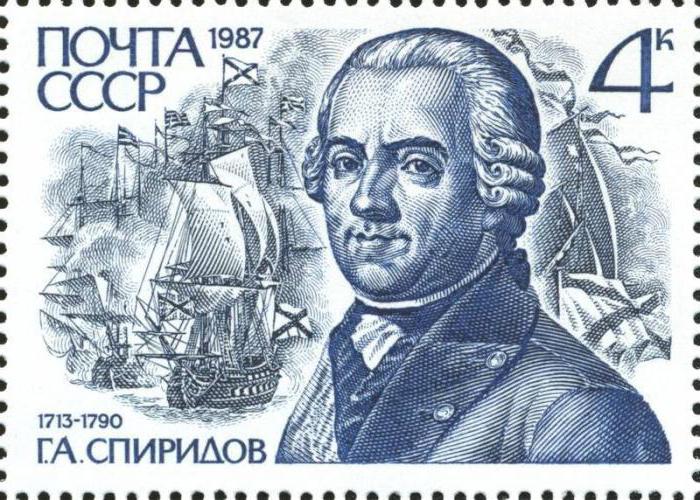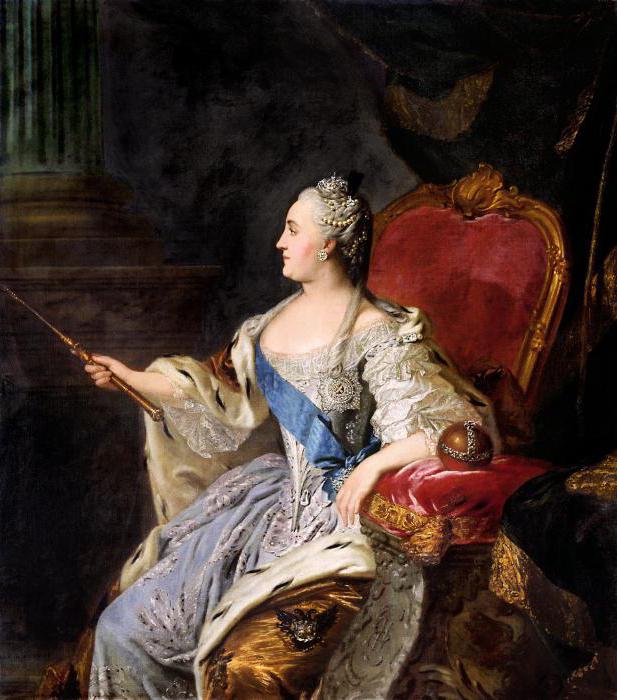Sometimes a story is unfair to people who have left a significant mark in it, and ascribes their services to others. But time puts a lot in its place and allows you to take a fresh look at past events. One of such people, whose feat was underestimated by contemporaries, is the hero of the Chesme battle - full admiral Spiridov Grigory Andreyevich, interesting facts from whose life are brought to the attention of readers of this article.
Midshipman Spiridov
The outstanding Russian naval commander Spiridov Grigory Andreevich was born on January 31, 1713 in the family of the commandant of Vyborg - the city that Peter I conquered from the Swedes during the Northern War. Having received a home education, befitting a young nobleman, he volunteered for the fleet. Already at the age of fifteen, having successfully passed the examinations in navigation sciences, he receives his first title - midshipman.
In that year, a group of young sailors was sent from St. Petersburg to the Caspian Sea, among which Spiridov also left for active service. Gregory, falling under the command of an experienced naval commander and hydrograph Aleksey Nagaev, very successfully mastered the wisdom of marine science. A few years later he was entrusted with the command of two geckbots - three-masted sailing ships for the transport of goods and landing. In those years, the sailing routes of Spiridov ran from Astrakhan to Persia.
Baltic Service
In 1732, a young and promising sailor was transferred to Kronstadt, where, having received an early rank of midshipman, he continued to serve on the ships of the Baltic Fleet, and six years later he was appointed adjutant of Vice Admiral Peter Bredale. It was next to this outstanding naval commander that the real combat training of the Spirids passed. Grigory Andreyevich, whose biography is inextricably linked with the history of the Russian fleet of those years, accompanied the vice admiral in the Azov expedition against the Turkish fleet and participated in all battles as part of the Don Flotilla.

After that, his track record is replenished with three years spent in the North of Russia, in Arkhangelsk, from where, on a newly built warship, Spiridov makes the transition to the berths of Kronstadt so memorable to him. Here over the next ten years, he commands not only linear vessels, but also - which is very important for his future career - court yachts. This gives him the opportunity to gain fame among the command of the Baltic Fleet, and most importantly - in the circles of the highest nobility.
The result was not slow to affect, and in 1754 his uniform was decorated with epaulettes of the captain of the third rank. In this title, Spiridov Grigory Andreevich becomes a member of the state commission, which was entrusted with the development of the new Charter of the Navy. At the end of his work, he is appointed head of the Naval gentry cadet corps, where, with the rank of company commander, Spiridov is preparing her future admirals for Russia.
Participation in the Seven Years War
Grigory Andreyevich spent the years of the Seven Years War, in which, along with many leading powers of the world, Russia also participated in the Baltic Fleet, performing combat missions, during which he led operations off the coast of Sweden, Danzig, Copenhagen and Stralsund. When, in 1761, General Petr Rumyantsev, who was besieging the Kolberg fortress (the present territory of Poland), needed reinforcements, it was Spiridov who delivered him two thousandth landing on his ships.

The young empress Catherine II, who ascended the throne in 1762, appreciated the merits of an “honest and brave officer” (General Rumyantsev spoke of him that way), and Grigory Andreyevich Spiridov was promoted to rear admiral with the appointment of Revel squadron as his commander. It was a very responsible post. The duties of the newly made admiral included ensuring the security of the Baltic sea communications. At the end of the Seven Years' War, he occupied the post of chief of the Kronstadt and Revel ports for some time, and then became the commander of the Baltic Fleet, where he once began his service as midshipman.
Hike for fame
But Spiridov showed himself most vividly in the battles of the Russian-Turkish war, which began in 1768 and lasted six years. By this time he received the rank of admiral, the Order of St. Alexander Nevsky and was appointed commander of the expedition of the navy, sent to the Greek archipelago. The squadron departed from the Kronstadt berths in July 1769 and six months later reached the Morea Peninsula in the southern Balkans, where, in accordance with the campaign plan, it merged with the ships of the second expedition led by Admiral John Elphinston.

After some time, General-General Aleksey Orlov, who arrived from Livorno, boarded the Empress Catherine II to command all the naval forces of Russia located in the Mediterranean Sea. With his arrival, active hostilities began, as a result of which the cities of Arcadia and Mystra were captured, as well as military bases located in Navarin and Itilon. To oppose the Russian fleet, the Ottoman Empire was forced to draw significant forces into this area.
Victory in the Chios battle
The first major battle with the Turkish fleet in this military campaign took place on June 24, 1770 and was called the Battle of Chios. In it, Orlov transferred all power to Spiridov, who, despite his personal hostility, was highly regarded as an experienced naval commander. According to contemporaries, Grigory Ivanovich used the tactics of sea battles, new for those times, in this battle , directing the vanguard of his ships at right angles to a chain of enemy ships and launching an attack on its center from a short distance. Such a decision entailed great responsibility, which Spiridov was not afraid to take upon himself.
Grigory Andreevich during the battle was on board the ship "Eustache" and was on the verge of death when it exploded during a boarding battle with the Turkish flagship "Real Mustafa". Both ships sank, and only by coincidence, the admiral survived and safely boarded the frigate "Three Hierarchs". In this battle, victory was on the side of the Russian fleet, which opposed almost twice the enemy.
Admiral's finest hour
However, still ahead was the main battle that Grigory Andreevich Spiridov won. The Chesme battle that took place on the night of June 24–25, 1770, became his truly high point. The commander of the Russian squadron, Count Orlov, with all his undeniable merits of a statesman and military leader, had no experience in naval battles. And although later it was he who won the glory of the winner in the Chesme battle, the real leadership in it was assigned to Spiridov.
Thanks to the maneuvers undertaken by him, the Turkish fleet was practically driven into the Chesme Bay and was in an extremely disadvantageous position. According to the admiral’s plan, the Turks were simultaneously subjected to artillery shelling and were attacked by firewalls - small vessels loaded with explosives and sent towards the enemy, in the event of a collision with which they exploded. Their crew, which had boarded in advance in boats, was selected by other vessels.
Such tactics allowed the Russians to set fire and send to the bottom most of the Turkish fleet, after which the Ottoman Empire permanently lost its sea power. The statistics of the ratio of losses incurred in this battle by warring parties is also impressive. It is known that among the Russians, eleven sailors died, while the number of killed and wounded Turks amounted to eleven thousand people. Simply put - 1 in 1000.
Stolen glory
This is a truly unique result in the history of not only naval, but also land battles. That day, along with the entire Russian squadron, its commander triumphed - Admiral Spiridov Grigory Andreevich. A photo of Aivazovsky’s painting, written in 1848 and depicting the scene of the legendary battle, is presented at the end of our article.
In honor of the glorious victory, or, as they used to say, “Victoria,” Catherine II ordered the construction of a church (her photo can also be seen in the article) and a memorial column. Spiridov Grigory Andreyevich himself, whose merits were undeniable, received only the order of the Holy Apostle Andrew the First-Called. The lion's share of honors and glory went to, as mentioned above, Catherine's favorite - Count Orlov.
Service in the Aegean
The admiral spent the next three years in the area of the Greek archipelago, creating the base of the Russian fleet on the island of Paros and from there controlling a significant part of communications in the Aegean Sea. He almost completely blocked the supply of weapons and provisions from Greece to Constantinople, and also carried out the blockade of the Dardanelles. In 1772, Spiridov, interacting with the ground forces, made a number of successful military operations against Turkish coastal fortresses, reaching Egypt and Syria in his campaigns.
Forgotten Heroes
In 1773, Honored Admiral Spiridov Grigory Andreyevich, whose brief biography formed the basis of this article, sent a letter of resignation to Petersburg. He was only sixty, but in his report he referred to poor health. The biographers consider the real reason for the reluctance to continue to serve as an insult to the fact that the victory in the Chesme battle was attributed not to him, but to the favorite of Catherine II - Count Orlov, who took only a passive part in the battle, but who went down in the history of Russia as his main character.
The admiral spent the rest of his life in his ancestral village Nagorye of the Pereslavl district, where he died on April 19, 1790. His death went unnoticed by Russia, which had long entered a new reign and was occupied with other problems. Only courtyard people and another man escorted the honored naval commander into the last journey — his friend, the same as he, the forgotten hero of the Chesme battle, Admiral Stepan Petrovich Khmetevsky.